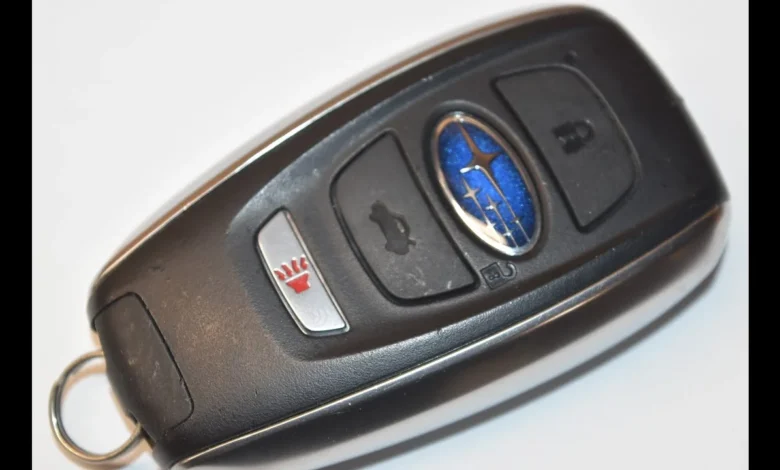Subaru Forester 2018 Key Fob Battery Replacement

Why Replace the Battery in Your 2018 Subaru Forester Key Fob?
Subaru Forester 2018 Key Fob Battery Replacement: Your key fob is the lifeline to your Subaru Forester’s remote locking, unlocking, and (if equipped) push-button start features. Over time, the coin (button cell) battery inside the fob will weaken and eventually fail. When that happens, you might observe:
-
Reduced range or intermittent operation of lock/unlock functions
-
The fob stops working entirely
-
Inability to remotely open doors or trigger panic / alarm
-
Possibly difficulty starting (on models where fob signal is needed)
Replacing the battery is typically quick, inexpensive, and manageable with basic tools. Doing so restores reliable remote functionality without needing to replace the entire fob. However, you must be careful to choose the correct battery type, avoid damaging the internals, and in some cases reprogram the fob so it communicates properly with your car.
In the next sections, we’ll cover battery types, tools & precautions, step-by-step replacement, reprogramming (if required), troubleshooting, and some best practices to extend battery life.
Battery Types & What’s Used in a 2018 Subaru Forester Fob
Before opening your fob, you should know which battery is compatible. Subaru has used a few common coin batteries depending on the fob design.
🔋 Common Battery Types
-
The newer rectangular / “bulging rectangle” style key fobs typically use a CR2032 lithium coin cell battery.
-
Older / teardrop fob designs may use CR2025 batteries (though less likely on a 2018 Forester).
-
The oldest style (with exposed metal key) can use CR1620 batteries in more vintage Subaru fobs.
For the 2015–2018 Forester models, many parts and replacement guides list CR2032 as the stock battery. Always verify by opening your exact fob — the imprint on the existing battery confirms compatibility.
✅ Tips for Choosing the Battery
-
Use brand name, high-quality lithium coin cells — cheaper ones may discharge quickly or fail to maintain firm contact.
-
Handle the battery by its edges to avoid depositing oils or contaminants on the contact surfaces.
-
Avoid mixing old and new batteries or different brands.
-
Make sure polarity (“+” side) is aligned correctly when replacing.
Tools & Precautions Before You Begin
Working on your key fob may seem simple, but a few preparations and precautions can prevent damage and ensure success.
🧰 Tools You’ll Need
-
Small flathead screwdriver or plastic pry tool
-
Soft cloth or pad to protect surfaces
-
Clean workspace with good lighting
-
(Optional) rubber or latex gloves to avoid fingerprints on battery
-
A new coin battery of the correct type
⚠️ Precautions & Tips
-
Work on a soft surface (cloth or mat) to catch small parts or prevent scratching.
-
Be gentle when prying — fob shells are plastic and can crack if forced.
-
Observe battery orientation before removing old battery (which side is up).
-
Avoid touching contacts — oils from skin reduce conductivity.
-
Keep small parts organized (like screws, tabs).
-
After replacement, test before fully reassembling to ensure the new battery works.
-
If your fob has built-in encryption or programming, be aware that in some Subaru models, replacing the battery might require reprogramming the fob to the car’s system.
Now, let’s walk through the step-by-step method for your 2018 Forester’s fob battery replacement.
Step-by-Step: Replacing the Key Fob Battery in a 2018 Forester
Below is a generic procedure. Always check your fob’s shape and refer to your owner’s manual or existing battery for guidance.
1. Remove the emergency (mechanical) key
Most modern Subaru key fobs (rectangle style) have a small silver tab on the back that you press to release the metal emergency key shank. Pull it out.
2. Separate the fob housing
-
Where the emergency key was, you’ll see a seam or gap between the two halves of the plastic shell.
-
Insert the tip of a flathead screwdriver or pry tool into this seam (or a small niche in side seam) and gently twist to pry the fob halves apart.
-
Be cautious — go slowly around the edges to avoid cracking tabs.
3. Locate and remove the old battery
-
Once opened, locate the coin battery — it may sit above or below the circuit board depending on design.
-
Carefully lift the old battery out from its clips or retaining tabs, remembering which orientation (polarity) it had.
-
Avoid moving or damaging the internal PCB or contacts.
4. Insert the new battery
-
Insert the new CR2032 (or whichever is correct) battery with the correct side facing up (usually the “+” side).
-
Press it into place so it’s snug and secure, making sure contacts touch firmly.
5. Reassemble the fob
-
Align the two halves of the fob and press them together, ensuring all tabs snap into place.
-
Reinsert the emergency key into its slot.
-
Before finishing, test the fob’s functionality (lock/unlock buttons) to ensure it communicates with the car.
At this point, the battery is replaced. But depending on your Forester’s system, you may need to reprogram or re-pair the fob.
Reprogramming or Resetting the Key Fob (If Needed)
Most of the time, replacing the battery is sufficient and the fob continues to function. However:
-
On some Subaru models and fob types, reprogramming or synchronization is required after battery replacement.
-
Some 2018 Forester owners have reported that after battery failure, their fobs stopped working entirely until reprogrammed.
Here’s a generic programming procedure that works on many Subaru models (especially older or simpler fobs):
-
Sit in the driver’s seat with all doors/windows closed, engine off.
-
Open the driver’s side door.
-
Use the door unlock button on the door panel.
-
Turn the ignition key to Accessory and back to Off, repeating 10 times quickly. You should hear a chime.
-
Open and close the driver’s door — the vehicle may chime again.
-
Within ~45 seconds, enter the first eight-digit serial number (found inside the fob when opened) using lock/unlock buttons (e.g. press lock for each digit, unlock to move to next).
-
If correct, a final chime should sound, doors may lock/unlock as confirmation.
-
Test the fob from outside the vehicle.
Note: newer rectangular fobs may only be programmed at a Subaru dealership or with specialized tools, and DIY methods may not work.
If after replacement and attempted programming, the fob doesn’t work, you may need dealer assistance or a professional locksmith with Subaru diagnostic tools.
Troubleshooting Common Issues After Replacement
If the new battery doesn’t fix the fob, or the fob behaves strangely, here’s what to check:
❗ Fob doesn’t work at all
-
Reopen and confirm the battery orientation — reversed polarity means no contact.
-
Ensure the battery is securely pressed and contacts are touching metal pads.
-
Check for debris, oxidation, or bent contacts that may prevent conduction.
-
The new battery might be dead or defective — try another fresh coin cell.
-
The fob circuit (PCB) might be damaged or internal parts broken.
⚠️ Weak range or intermittent function
-
Weak battery contact or partial seating may reduce radio transmission.
-
Antenna traces or contacts on the PCB could be damaged.
-
Interference or environmental issues — test at different distances.
-
Some buttons may be failing or worn.
🔁 Fob functions for some buttons but not all
-
The physical button membrane or contacts under specific buttons might be worn.
-
Check internal membrane or switch contacts for damage.
🔐 Reprogramming doesn’t work
-
You may have missed the timing window in the programming sequence.
-
The fob might be an advanced encrypted type requiring dealership programming.
-
The serial number code might have been entered incorrectly.
-
The car’s receiver module (immobilizer) may not detect the fob if its circuit is faulty.
🔧 Wear, cracks, or damage
-
If the plastic shell is cracked or warped, the halves might not align correctly, causing poor sealing or contact misalignment.
-
Exposure to moisture or extreme temperatures might accelerate wear or damage.
If troubleshooting fails, consult a Subaru dealership or qualified auto locksmith who has the tools to diagnose or replace your fob’s electronics.
Best Practices & Tips for Longevity
To minimize future key fob battery issues and ensure reliable operation, here are some best practices:
-
Replace the key fob battery every 2–3 years proactively rather than waiting for failure.
-
Don’t leave the fob in extreme heat (car interior under sun) or extreme cold for long periods.
-
Avoid pressing buttons continuously or dropping the fob.
-
Keep a spare coin battery (CR2032) in your glove box or toolbox.
-
When you start to sense weaker range or inconsistency, replace the battery early before complete failure.
-
Clean contact surfaces gently (alcohol wipe) during replacement to maintain conductivity.
-
If you have two fobs, swap them occasionally to avoid one remaining unused for years with a dead battery.
-
If your region is humid or dusty, ensure the fob casing remains sealed well after reassembly.
Conclusion
Replacing the key fob battery in your 2018 Subaru Forester is a relatively simple and cost-effective way to restore remote access functionality and prevent being locked out unexpectedly. The key steps are:
-
Identify and purchase the correct battery type (usually CR2032 for many Forester fobs).
-
Gently open the fob housing, remove the old battery, and insert the new one with correct orientation.
-
Close and snap the fob back together, test the remote functions.
-
Reprogram or synchronize the fob if your model requires it (DIY for some, dealership for advanced fobs).
-
Troubleshoot issues like no function, weak range, or programming errors.
-
Follow best practices to maintain fob reliability and extend battery life.
If you like, I can find model-specific instructions (with pictures) for your exact Forester trim and year, or even a video guide.




